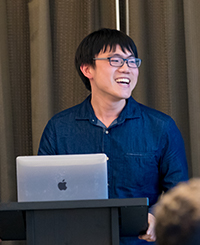 Wai Cheung (Adrian) Chan
Wai Cheung (Adrian) Chan
Chemical Biology PhD Program
I am a joint student in Sara Buhrlage’s and Jarrod Marto’s labs at the Dana-Farber Cancer Institute. My research focuses on the development of mass spectrometry chemoproteomic technology for the discovery, characterization, and validation of inhibitors targeting the deubiquitinating enzymes.
Where are you from, where did you study prior to this, and what brought you to HMS?
I grew up in Hong Kong, but I spent part of my adolescence in the Netherlands. I graduated as a double major in Chemistry and English from Amherst College, where my research focused on small molecule probes to research protein tyrosine phosphatases in Anthony Bishop’s lab. I joined Harvard’s Chemical Biology PhD program to continue developing new small molecules for emerging target classes in a world-class setting with supportive, collaborative colleagues and mentors.
How does your research hold promise for therapeutic innovation?
Inhibiting the deubiquitinating enzymes (DUBs) offers the exciting potential to degrade pathogenic proteins as a novel therapeutic strategy. I am working on a platform that combines chemoproteomics, a novel DUB-targeting small molecule library, and orthogonal validation assays for DUB inhibitor discovery. In terms of therapeutic innovation, my work holds promise towards first-in-class DUB drugs, medicinal chemistry insights for what makes a good DUB inhibitor, as well as a generalizable chemoproteomic platform applicable to other target classes.
What was your reaction when you learned you were named a Fujifilm Fellow?
I was very excited and honoured to be named a Fujifilm Fellow. Fujifilm is a company I grew up with, so it was particularly encouraging to receive support from a familiar name.
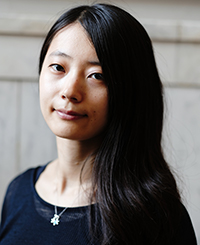 Reina Iwase
Reina Iwase
Biological and Biomedical Sciences (BBS) PhD Program
I am a biochemist interested in studying the mechanisms by which various proteins function. I will be starting my research in the lab of Dr. Philip Cole.
Where are you from, where did you study prior to this, and what brought you to HMS?
I am a second-year graduate student in the Biological and Biomedical Sciences (BBS) program. I am from Tokyo, Japan, and first came to Boston in 2013 to pursue my BA/MA degree in biochemistry and molecular biology at Boston University. I worked as an undergraduate researcher for three years in the Whitty Research Group, where I deepened my interest in protein-protein interactions. With Dr. Adrian Whitty’s encouragement, I applied to the BBS program for my graduate studies. I chose to study at Harvard because of its highly collaborative environment with many talented individuals.
How does your research hold promise for therapeutic innovation?
I will be studying how PTEN, a phosphatase inactivated in many tumor cells, is regulated by N-terminal ubiquitination. There is currently little known about the effects of ubiquitination on structure and activity of PTEN. A deeper understanding of PTEN regulation would help guide the development of a novel PTEN-based anti-tumor therapeutics.
What was your reaction when you learned you were named a Fujifilm Fellow?
I was surprised for being named as a Fujifilm fellow. I am very grateful for this honor and the support from a famous Japanese company.
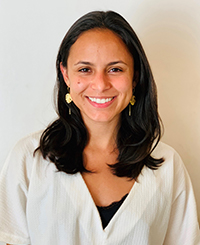 Alyssa Larios
Alyssa Larios
Neuroscience PhD Program
I am a first-year student in the process of identifying my thesis lab and advisor.
Where are you from, where did you study prior to this, and what brought you to HMS?
I grew up in Southern California and graduated from Northwestern University, where I studied Neuroscience and Biochemical Engineering. I have always been fascinated by the remarkable complexity of the brain and its control over every aspect of life. I’ve found that the neuroscience community at Harvard Medical School is rich with scientists who both share these curiosities and inspire the field at large.
How does your research hold promise for therapeutic innovation?
Parkinson’s disease is characterized by a progressive loss of dopamine neurons in the midbrain, resulting in a depreciation of voluntary movement control. The current therapies aim to mitigate motor deficits through global dopamine replacement, yet the role of dopamine is not completely understood on circuits modulating action selection, reward-seeking, and motivation. My research background includes investigating the role dopamine plays in guiding behavioral decisions in healthy brains to further understand the neural circuitry affected by Parkinson’s disease. Describing how different neural ensembles respond to dopamine input to produce complex behavioral sequences can uncover novel strategies for symptom management and therapeutic treatment in patients with Parkinson’s disease.
What was your reaction when you learned you were named a Fujifilm Fellow?
When I learned I was selected for the fellowship, I was honored to receive the support. I’m so excited to be included in FUJIFILM’s mission for advancing therapeutic science and building a collaborative scientific community.
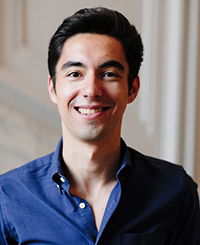 Michael Mazzola
Michael Mazzola
Biological and Biomedical Sciences (BBS) PhD Program
I joined Dr. David Scadden’s laboratory at the Center for Regenerative Medicine at Massachusetts General Hospital to study blood stem cells, particularly in the context of bone marrow transplant. Blood stem cells are responsible for making all blood cell types in the body and reside in the bone marrow.
Where are you from, where did you study prior to this, and what brought you to HMS?
After growing up on Long Island, New York, I attended Cornell University, where I studied Biology and minored in English and Biomedical Engineering. Hoping to pursue a career in the field of therapeutics, I decided to pursue a PhD at Harvard Medical School.
How does your research hold promise for therapeutic innovation?
For patients that have genetic blood diseases like sickle cell anemia or hemophilia, bone marrow transplants replace unhealthy blood stem cells with healthy blood stem cells. Great progress has been achieved in the field of gene therapy, which can correct the genetic mutations that cause diseases. However, transplants require that stem cells be removed from patients’ bone marrow so that gene therapy can be performed in a laboratory. When hematopoietic stem cells are taken out of our bodies and placed in a dish, the cells become stressed and can lose their capacity to make blood.
My thesis aims to improve transplantation by better understanding how hematopoietic stem cells respond to and survive stress. With this knowledge, strategies to cure hematopoietic diseases by gene therapy and bone marrow transplant will be more effective at normalizing patients’ blood.
What was your reaction when you learned you were named a Fujifilm Fellow?
When I learned that I was named a Fujifilm Fellow, I was excited to share the news with my unconditionally supportive parents and laboratory. I am so happy to be supported by Fujifilm, which shares my enthusiasm for the future of cell-based therapies.
 Martha Ordonez
Martha Ordonez
Biological and Biomedical Sciences (BBS) PhD Program
I recently joined the lab of Dr. Edward Chouchani in the department of Cell Biology at HMS. Research in the lab focuses in deciphering the molecular mechanism that drive metabolic diseases for therapeutic applications. My research project focuses on small molecule therapeutics to treat obesity and obesity-linked disorders.
Where are you from, where did you study prior to this, and what brought you to HMS?
I was born in Ecuador, but my family and I moved to the United States when I was 8 years old in search for better economic and educational opportunities. I completed my undergraduate studies at Hunter College, where I was a member of the Research Initiative for Scientific Enhancement (RISE) program. Being a RISE fellow gave me the opportunity to pursue research opportunities in biomedical sciences at Hunter College and encouraged me to pursue summer research at other institutions. As a result, I applied and was accepted to two summer internships at Harvard University. Upon the completion of my undergraduate degree, I sought out additional research opportunities in the biomedical sciences and did a two-year post-baccalaureate at Harvard University.
I decided to pursue my PhD in the Biological and Biomedical Sciences (BBS) program at Harvard Medical School because it is a welcoming setting that is devoted to cultivating an atmosphere that encourages students to think creatively and critically as they develop into independent investigators.
How does your research hold promise for therapeutic innovation?
There is a major need to develop drugs that target obesity and obesity-linked disorders, such as diabetes and NASH, which are leading causes of death worldwide. A well-established approach to reverse obesity is activation of calorie-burning in brown adipose tissues (BAT). BAT has the unique capacity to catabolize fat and glucose in futile thermogenic cycles that are protective against obesity. The major protein effector of thermogenesis in BAT is uncoupling protein 1 (UCP1). To date, UCP1 has been considered “undruggable,” lacking obvious modes of small molecule pharmacological engagement for therapeutic activation. My host lab recently discovered that UCP1 contains a functional cysteine residue that when post-translationally modified can increase protein activity. This newfound site represents the first known activation site of UCP1.
My research will apply new mass spectrometric and chemical technologies to identify small molecules that can modify this newfound active site on UCP1. We predict that chemical modification of this site will activate the calorie burning activity of UCP1, effectively acting as a molecular switch to drive calorie burning. These molecules could hold major promise as treatments for obesity and diabetes, where excess calories are a major driver of disease and death.
What was your reaction when you learned you were named a Fujifilm Fellow?
I am extremely excited for the opportunity given to me to continue working towards novel scientific discovery. I am looking forward to future scientific experiences as part of being a Fujifilm fellow and the opportunity to share my findings with the science community.
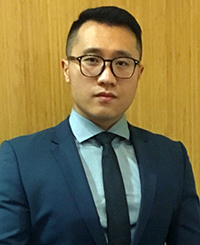 Yingxiao (TK) Shi
Yingxiao (TK) Shi
Biological and Biomedical Sciences (BBS) PhD Program
The idea of oncogene and non-oncogene addiction is fascinating to me. The genetic alterations in tumor cells start from an initial simple mutator mutation following by sequential, multi-step mutagenesis and selections. Moreover, as a result of the accumulation of the mutations, the bulk tumor might include a diverse collection of clones harboring distinct molecular signatures with different levels of sensitivity to treatment. Therefore, I wonder would it possible to classify and build this gene mutation hierarchy and distinct the different driver clones within the tumor based on their unique genetic features to navigate the actual therapy from different paths for cancer treatment. With this purpose, I am currently doing my rotation in Dr. William Hahn’s lab, which mainly focuses on developing systematic approaches to determine and characterize genes that drive cancer initiation, progression, and tumor maintenance.
Where are you from, where did you study prior to this, and what brought you to HMS?
I am originally from Nanjing, China. To fulfill my passion for biology, I left my homeland and my family to study life sciences in the Netherlands (HAN University of Applied Science). As an undergraduate student, I was fascinated with induced pluripotent stem cells (iPSCs) technology due to its therapeutic potential, such as in the study of neuron degeneration diseases. To gain a better comprehension of this, I studied iPSCs technology in Dr. Niels Geijsen’s lab at the Hubrecht Institute and upper motor neuron conversion from iPSCs in Dr. Paola Arlotta’s lab (in collaboration with Dr. Fengzhang’s lab) as my undergraduate internship.
Throughout my time on both of my undergraduate internship projects, I found it fascinating how we could recapitulate what happens in a human body faithfully in a petri-dish and use it as a platform for disease mechanism discovery. I was eager to explore the research possibilities in this realm. With such a question, I was recruited by Dr. Justin Ichida, a fellow researcher from Harvard, who was starting a new lab at the University of Southern California.
In Dr. Ichida’s lab, I embarked on a five-year journey applying stem cell technologies to studying and potentially treating Amyotrophic Lateral Sclerosis (ALS). I focused on the most common genetic cause of the disease, an extended hexanucleotide GGGGCC expansion in the 72nd open reading frame on chromosome 9 (C9ORF72). After days and nights of trying to get the best motor neuron conversion, gene editing efficiency, disease-relevant stress conditions, and downstream molecular readouts, I was eventually able to show that the motor neuron degeneration in C9ORF72 type ALS patients was caused by a cooperativity between the gain-of-function from toxic aggregates and the loss-of-function from C9ORF72 gene products on protein trafficking.
The experience where I used my knowledge in stem cell biology to derive patient-specific motor neuron phenotypes for therapeutic compound high-throughput screening strengthened my belief that translational research could indeed one day provide effective therapeutic treatments. With this goal, I pursued other potential drugs for ALS. In collaboration with Dr. Berislav V. Zlokovic’s lab, I found that Active Protein C (APC), which was previously shown to block neuron apoptosis and to alleviate disease-mimicking phenotypes in rodent ALS models, rescued patient-specific motor neuron phenotypes via improving autophagosome functions.
This was an exciting time for me as I had potentially discovered a new therapeutic pathway for ALS, but the final stage of submitting my APC manuscript, I abruptly needed to travel home to China to be by my mother’s side as she went through the final stage of cancer, and sadly her life. I was so incredibly frustrated that better therapies for breast cancers are not as readily available in China as they are in the US, and that as a whole how poor the prognosis is for late-stage cancers in general. Through my angst and grief came the vivid realization and understanding of the importance of scientific research. The helplessness and frustration for my mother have transformed me in many ways. It has given me drive and purpose to apply myself in cancer research. I want to replicate the story of Herceptin. I want to make immunotherapy more individualized. I no longer want to see desperate patients. I will devote my career to the disease that took my mother away in the hope of making the prognosis better for the next patient.
Being one of the world’s leading cancer research organizations, Dana-Farber Cancer Institute has a long history of fighting cancer since 1947. Moreover, close collaboration with multiple hospitals such as Massachusetts General Hospital provides opportunities for close interactions between patients and researchers, so that the patients can benefit from the latest discoveries and innovative treatments. Overall, it is one of the best places for cancer research and it will be my great honor to further my research and study here.
How does your research hold promise for therapeutic innovation?
Intratumor heterogeneity is a critical obstacle to conquer when designing the most effective therapeutic strategies for patients with cancer. The poor understanding of the genotypic and phenotypic variation of different clones within one tumor can cause ineffective treatment and drug resistance. Therefore, only by well-characterizing gene mutations from each tumor clone and understanding each clone’s role in tumor formation would allow us to develop effective combination treatments to treat cancer systematically.
What was your reaction when you learned you were named a Fujifilm Fellow?
I cannot believe it! I learned that the Fujifilm Fellowship only provides funding to the most promising PhD students across the nine HMS-based life sciences PhD programs. I am truly honored to be selected among all of the excellent candidates.